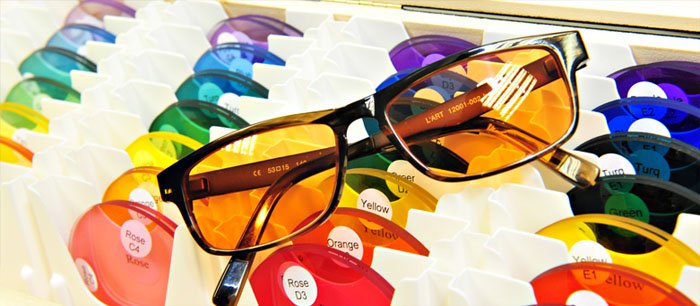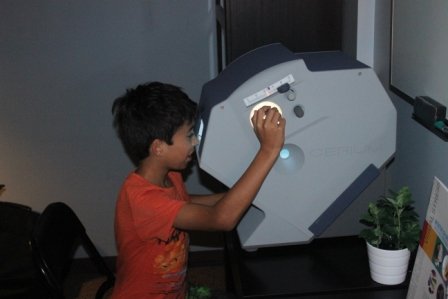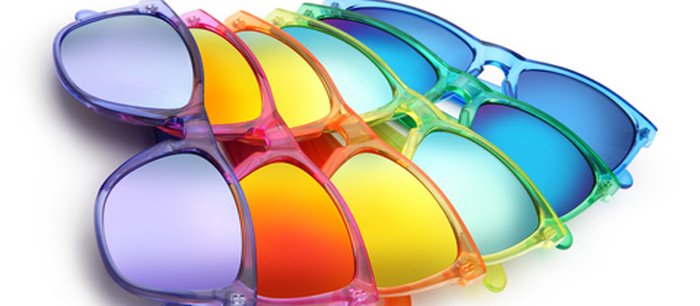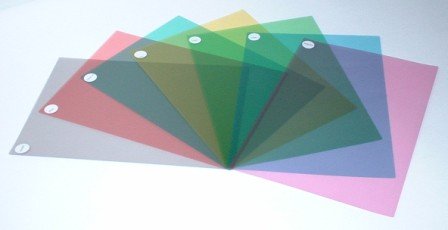Tinted Lenses / Dyslexia Glasses

Quick facts about tinted lenses for dyslexia / dyslexia glasses:
- Some reading problems have been associated with visual stress also referred to as Scotopic Sensitivity Syndrome and Irlen Syndrome
- Assessment of visual stress usually involves pattern glare tests, overlay screening and use of an Intuitive Colorimeter
- One kind of treatment for reading problems associated with visual stress is the use of prescription glasses with colour tinted lenses
- Coloured overlays for reading are also commonly used
- This treatment for dyslexia, although widely available, remains controversial
- In July 2009 and again in 2014, several leading American professional organizations on vision issued a joint statement against the use of vision therapy and coloured lenses in the treatment of learning disabilities based on a lack of evidence
- Despite the establishment position, many academics, several companies and thousands of users claim that color makes a big difference for some struggling readers
Who is wearing the rose coloured glasses?
According to one legend, early mapmakers used special lenses while tending to the fine details of their work. To keep their lenses spotless, some used rose petals to clean dust and debris from the lens' surface. Over time, the trace oils in the petals would stain the lenses a light tint of rose. Seeing the world through rose colored glasses came to mean an attention on detail at the expense of the bigger picture, and later, to see the world in an overly optimistic and romantic way.
I like the legend, though as a person of spectacles, I doubt rose petals ever made for good lens wipes. But rose colored lenses, some say, just might actually make it easier for a dyslexic to read printed text.
Opinions on glasses for dyslexia are, aptly, polarized. Most professional associations to do with vision have come out against the use of tinted lenses for treating learning disabilities based on a lack of evidence. Yet the lens makers, many academics and thousands of users of the lenses claim otherwise.
The vocabulary of visual stress
The problem(s) that dyslexia glasses, or any tinted product is actually solving is referred to by many terms, largely used interchangeably. Helen Irlen had originally used the term Scoptic Sensitivity Syndrome, referring to the light within the scotopic range of the visible light spectrum, but later adopted the simpler Irlen Syndrome.
Some older reference can also be found to Meares-Irlen Syndrome, acknowledging the contribution of Olive Meares, a New Zealand teacher who identified the same symptoms as Irlen at approximately the same time. Then there are sporadic references to the cumbersome "arrhythmic saccade and foveation during edge detection iterative arrays" (ASFEDIA) — a highly specific and technical description of the problem, but it is not commonly used.
Today the most common term used is simply visual stress. According to the Irlen website, the use of this term is "an attempt to simplify and generalize the name with the hopes to garner broader acceptance and understanding of the disorder."
The definition of visual stress / Irlen syndrome provided by Irlen is: A perceptual processing disorder. It is not an optical problem. It is a problem with the brain’s ability to process visual information. This problem tends to run in families and is not currently identified by other standardized educational or medical tests. (Source: Irlen Diagnostic Clinic)
Symptoms of visual stress
|
This Irlen video demonstrates how those experiencing visual stress may see text |
The symptoms of visual stress are many and not universally agreed upon but often include the following:
Reading Related Signs
- Text appears to move, words may move together becoming unrecognizable
- Individual words my blur, float or have a halo around them
- Lines of text may ripple, see-saw up and down, become wavy, shaky, washout or swirl around
- Headache or migraines from reading
- Fatigue quickly when working with text
- Problems copying from the board
- Skip words or lines when reading
- Movement of the head or body during reading—moving closer to or further away from the page
- Reading slowly and haltingly and difficulty absorbing information
- Tracking words with a finger
Other Signs
- Problems with depth perception such as judging distance or height
- Discomfort with fluorescent lighting
- Discomfort using computer screens
- Discomfort with busy patterns, particularly horizontal stripes
- Discomfort with sharp contrasts such as black text on white paper
Assessment
 The Intuitive Colorimeter (Opticalm Canada)
The Intuitive Colorimeter (Opticalm Canada)Assessment or screening for visual stress usually involves several elements:
Pattern Glare Test: Helps identify patients susceptible to pattern glare, defined as perceptual distortions and discomfort from seeing specific patterns. Those that experience discomfort are more likely to suffer from visual stress and likely to find colour filters helpful.
Overlay Screening: Involves placing coloured plastic overlays on text in order to determine the optimal colour for reducing visual stress.
Intuitive Colorimeter: A device used to find the optimal tint for reducing perceptual distortions from visual stress. The device varies hue, saturation and brightness until the patient arrives at an optimal color. The color is then incorporated into precision tinted dyslexia glasses. The Colorimeter was invented by Dr. Arnold Wilkins from the University of Essex.
Controversy
In a July 2009 issue of the journal Pediatrics, a joint statement on learning disabilities, dyslexia and vision was issued by the American Academy of Pediatrics, the American Academy of Ophthalmology, the American Association for Pediatric Ophthalmology and Strabismus, and the American Association of Certified Orthoptists.
In the section of the statement on controversies they write:
|
"Tinted lenses and filters have been suggested to treat visual perceptual dysfunctions that lead to visual distortion caused by sensitivities to particular wavelengths of light but not to treat language-based dyslexia. Scrutiny of published study results that advocated the use of these therapies to treat dyslexia have shown serious flaws in their methods and have not been sufficiently well controlled to support this assertion. There have also been many inconsistencies in the results, with some studies showing some partial positive results and others showing negative results. The method used to select the lens or filter color has been highly variable, the color selection has also shown considerable variability, and the test-retest consistency has been poor. Many of the studies that have been cited as proof of Irlen-lens efficiency have actually been inconclusive after deeper analysis. The evidence does not support the effectiveness of tinted lenses and tinted filters in these patients because of the weaknesses in methodology and statistics, variability in techniques in the trials, and the largely negative results." |

The article cited numerous studies in coming to its conclusion. The joint statement was re-affirmed in July 2014. You can read the complete joint statement here. This statement came nine years after a similar 2004 statement from the American Optimetric Association:
|
"There is evidence that the underlying symptoms associated with the Irlen Syndrome are related to identifiable vision anomalies, e.g., accommodative, binocular, and ocular motor dysfunctions, in many patients seeking help from colored lenses. Furthermore, such conditions return to normal function when appropriately treated with lenses, prisms, or vision therapy. When patients exhibiting the Irlen Syndrome were treated with vision therapy, their symptoms were relieved. These patients were no longer classified as exhibiting this syndrome, and therefore did not demonstrate a need for the colored overlays or tinted lenses." |
This statement directly contradicts a claim made by the Irlen Diagnostic Clinic:
"Scotopic Sensitivity Syndrome is a distinctively different visual
problem from visual acuity and refractive errors. Therefore, visual
examinations by ophthalmologists and optometrists will not detect this
condition. Scotopic Sensitivity Syndrome is different condition from that which is
evaluated by a developmental optometrist. Therefore, this condition is
not amenable to vision therapy."
 Coloured overlays for reading
Coloured overlays for readingMaking sense of it all
As of 2014, the consensus of the optical establishment is clearly against coloured lenses as a viable treatment for learning disabilities, and their judgement warrants consideration if you are considering trying them.
Nonetheless, it is increasingly recognized that there are visual aspects to dyslexia and with over 300 centers (see below) providing coloured lens services, there are obviously a lot of clients who feel they are benefiting. Even if the benefits were explained by a placebo effect, the benefits would still be real.
We haven't attempted here to weigh all the evidence for and against the use of tinted dyslexia glasses simply because there is far too much and it wouldn't put an end to the debate. Suffice to say that the the use of lenses is not mainstream treatment for dyslexia and has not won over the professional optometric community.
Glasses providers and related organizations
There are two major manufacturers of tinted lenses:
Irlen clinics can be found in 146 locations in the United States and in 46 other countries including Canada and the United Kingdom.
Chromagen clinics can be found in the 190 locations in the United States, four Canadian provinces and in 5 other countries.
In the United Kingdom there is a professional association called the Society for Coloured Lens Providers or S4CLP. They also maintain an international directory of service providers.
Final thoughts on dyslexia glasses
Every major North American professional association related to
pediatrics and optometry has come out against tinted dyslexia glasses as
a treatment for learning disabilities. This is a sobering thought that you should consider. From a clinical perspective, dyslexia is a neurological, auditory processing problem associated with a weakness in phonemic awareness. When defined this way, there is essentially no way for it to be treatable with tinted products.
But dyslexia does have a visual component and personally, we know of several people who swear by the lenses and any online search can turn up dozens of glowing testimonials and anecdotal evidence supporting the use of glasses. Also, we have been impressed with the rigour and depth of assessment used at our local Opticalm Canada centre where my stepson was assessed. This doesn't mean that coloured lenses will work for you, but we think it can't hurt to try a coloured overlay and see what happens. There is virtually no risk and little cost in trying. If it makes a big difference for you or your child, then you have little to lose by giving tinted glasses a try.
Back to the top of Dyslexia Glasses
- Home ›
- Assistive Technology ›
- Dyslexia Glasses
New! Comments
Share your thoughts or ideas! Leave us a comment in the box below. You can post it at this site only or on Facebook too, it's up to you.